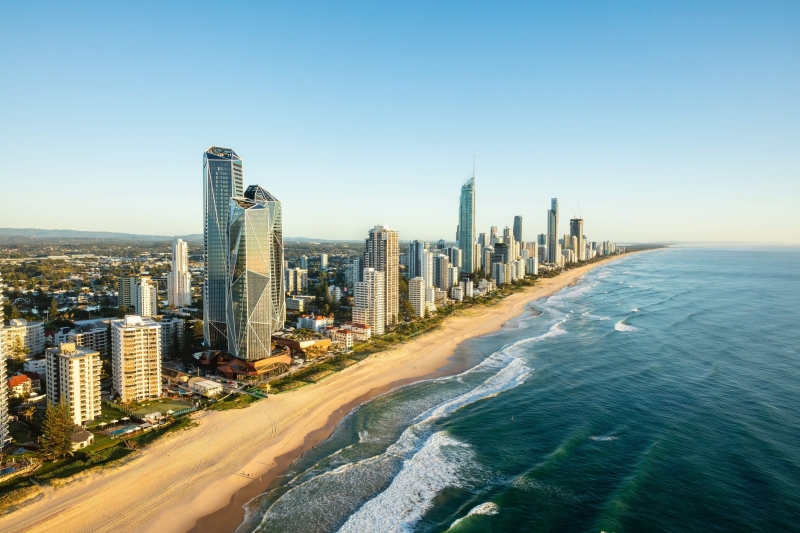
The Australian invention for events during COVID-19
What started as an idea for a simple social distancing alert system developed by an Australian production company to help restart events in the wake of a global pandemic has evolved into a dynamic, automated safety device being adopted by multiple industries navigating the challenges of COVID-19.
“Harry the hirer was looking for something to try and help the events industry get back up on its feet as quickly as possible,” says Brad Johnson, national sales manager for Smart Badge, a subsidiary of Australian events industry heavyweight Harry the hirer.
“Our business went from 1,000 staff down to about 50 in about the space of a week, so we were obviously very motivated to find something that would get the events industry as a whole back.

Southbank. Melbourne, Victoria © Daniel Tran
In Melbourne restrictions on gatherings have been eased, with capacities depending on the type of venue. Melbourne Convention and Exhibition Centre has recently had its capacity increased to 75 per cent capacity per event space, to a maximum of 5,000 attendees. Other venues are limited by a one person by two square metre rule while seated indoor entertainment venues can operate at 75 per cent of capacity, up to 1,000 people.
“We wanted it to be an automated system where each device wearer was alerted automatically to say, ‘You’re too close, step back’.”
Fast forward ten months and there are more than 55,000 Smart Badges in Australia, which also have contract tracing abilities.
The Smart Badge works by using Bluetooth to detect proximity to other Smart Badges and using nodes placed around a site to scrape data from nearby badges to upload to a cloud which stores each Badge interaction.
“If we have nodes in a room and the badges are always in range of those nodes then the [contract tracing] data is 100 per cent live down to about three seconds of being uploaded from the time that it happens to being visible on the [organiser’s] dashboard,” says Johnson.
For added security, contact details of the badge holder – which can be added via bulk registrations or scanning a QR code – and contract tracing information are stored separately and only brought together if a contract tracing check is completed. Companies and event organisers can also anonymise details of who has each device.
In addition, the nodes act as capacity monitors, letting organisers know in real time how many people are in a space.
Badges can also be modified to allow groups known to each other to be within 1.5m (approx. 5ft) of one another. And there are other features in the pipeline.
“On our development roadmap there is certainly a geo mapping, heat mapping system,” says Johnson.
“If we have nodes set up in certain locations in a space, you can understand how many people would be standing out the front of [for example] an expo booth.
“That data is pretty powerful stuff whether you use it in real time or historically. How does an exhibitor use that data or how does an organiser use that data?”

Colour Me Brisbane Sign, Brisbane, Queensland © Brisbane Marketing
Events in Brisbane have no maximum cap on numbers, provided each attendee has at least 2sqm of space.
Johnson believes it could be used to inform better stand design and orientation and help organisers demonstrate opportunity for return on investment for exhibitors. The implications of this are significant for meetings which are financially supported by their exhibition component.
With Melbourne’s restrictions easing again in late 2021 and events slowly restarting in many parts of Australia, the Smart Badge’s initial development – and current usage – has been driven by a less obvious source.
“As we put the idea in front of our events clients, there was a real [realisation that] this [wasn’t] just an event specific product, particularly once we got to the contract tracing development side of it,” says Johnson.
“It became apparent that every industry, every business, Australia wide or globally, has… a need to do contract tracing and under the current conditions, social distancing was really a relevant thing as well.
“It became, rather than an events-specific product, almost a workplace safety product for any industry and any business.”
As well as the event-friendly lanyard design, the device also comes in a wristwatch style, and in a waterproof version.
“The devices all look exactly the same but there’s been a lot of changes to the devices as a result of conversations with various businesses and what their requirements are.
“We’re developing the idea of RFID or HID access into a swipe card system where the device will do your swipe access into a building and social distance you and give you a contract tracing solution at the same time – an all in one [device] and that gives it longevity after coronavirus,” says Johnson.

Perth, Western Australia © Tourism Australia
In Perth, there is no cap on numbers of attendees for business events, provided each attendee has at least 2sqm of space. Business events of up to 900 people have resumed in Australia’s largest west coast city.
The next iteration of the Smart Badge is in development with “increased functionality to make it more of a general product as well as Covid specific”.
“There’s a big list of things that we could put in them and we’re making a very conscious decision to say, ‘Let’s be specialists in some things’ – we don’t want to try to take on Apple or Samsung, because they do everything. We just want to be very good at a few things and make them business specific and still have the ability to tailor it to certain businesses or certain industries,” Johnson adds
But for right now, the contract tracing element of the Badge is its biggest drawcard.
“The thing that differentiates us mostly from every other player in this market at the moment – and it’s a pretty hot little market, there are businesses popping up all over the world doing similar things – [is] the fact that ours is an automated and real time data system. There’s a lot of real intuitive functionality that we’ve designed into the backend [and] no other system that we’ve found can do any of that,” says Johnson.
Published: 22 January 2021

















